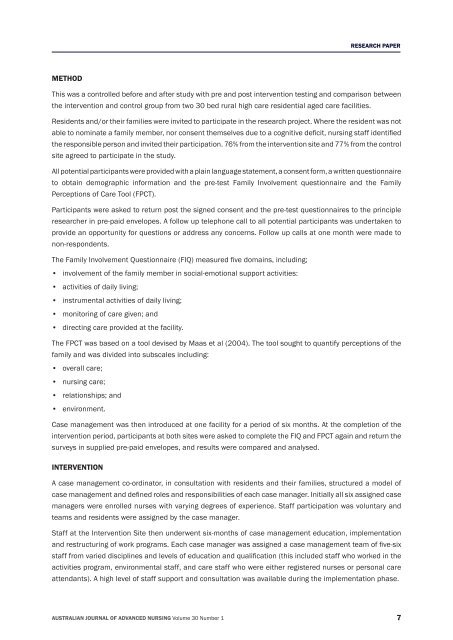Download Complete Issue - Australian Journal of Advanced Nursing
Download Complete Issue - Australian Journal of Advanced Nursing
Download Complete Issue - Australian Journal of Advanced Nursing
Create successful ePaper yourself
Turn your PDF publications into a flip-book with our unique Google optimized e-Paper software.
RESEARCH PAPER<br />
METHOD<br />
This was a controlled before and after study with pre and post intervention testing and comparison between<br />
the intervention and control group from two 30 bed rural high care residential aged care facilities.<br />
Residents and/or their families were invited to participate in the research project. Where the resident was not<br />
able to nominate a family member, nor consent themselves due to a cognitive deficit, nursing staff identified<br />
the responsible person and invited their participation. 76% from the intervention site and 77% from the control<br />
site agreed to participate in the study.<br />
All potential participants were provided with a plain language statement, a consent form, a written questionnaire<br />
to obtain demographic information and the pre‐test Family Involvement questionnaire and the Family<br />
Perceptions <strong>of</strong> Care Tool (FPCT).<br />
Participants were asked to return post the signed consent and the pre‐test questionnaires to the principle<br />
researcher in pre‐paid envelopes. A follow up telephone call to all potential participants was undertaken to<br />
provide an opportunity for questions or address any concerns. Follow up calls at one month were made to<br />
non‐respondents.<br />
The Family Involvement Questionnaire (FIQ) measured five domains, including;<br />
• involvement <strong>of</strong> the family member in social‐emotional support activities:<br />
• activities <strong>of</strong> daily living;<br />
• instrumental activities <strong>of</strong> daily living;<br />
• monitoring <strong>of</strong> care given; and<br />
• directing care provided at the facility.<br />
The FPCT was based on a tool devised by Maas et al (2004). The tool sought to quantify perceptions <strong>of</strong> the<br />
family and was divided into subscales including:<br />
• overall care;<br />
• nursing care;<br />
• relationships; and<br />
• environment.<br />
Case management was then introduced at one facility for a period <strong>of</strong> six months. At the completion <strong>of</strong> the<br />
intervention period, participants at both sites were asked to complete the FIQ and FPCT again and return the<br />
surveys in supplied pre‐paid envelopes, and results were compared and analysed.<br />
INTERVENTION<br />
A case management co‐ordinator, in consultation with residents and their families, structured a model <strong>of</strong><br />
case management and defined roles and responsibilities <strong>of</strong> each case manager. Initially all six assigned case<br />
managers were enrolled nurses with varying degrees <strong>of</strong> experience. Staff participation was voluntary and<br />
teams and residents were assigned by the case manager.<br />
Staff at the Intervention Site then underwent six‐months <strong>of</strong> case management education, implementation<br />
and restructuring <strong>of</strong> work programs. Each case manager was assigned a case management team <strong>of</strong> five‐six<br />
staff from varied disciplines and levels <strong>of</strong> education and qualification (this included staff who worked in the<br />
activities program, environmental staff, and care staff who were either registered nurses or personal care<br />
attendants). A high level <strong>of</strong> staff support and consultation was available during the implementation phase.<br />
AUSTRALIAN JOURNAL OF ADVANCED NURSING Volume 30 Number 1 7

















